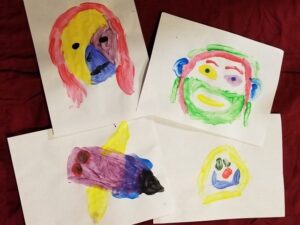
4 Reasons Why Every Child Should See Inside Out (And 3 Reasons Parents Should Watch It, Too)
In 2015, Disney Pixar released a movie called Inside Out. In the movie, a young girl named Riley has to move across the country because her father gets a new job. When she is uprooted from her simple, Midwestern life and brought into the hustle and bustle of San Francisco, her emotions–namely, Joy, Fear, Anger, Disgust, and Sadness–struggle to cope with the effects that the move has on Riley.
Inside Out takes the emotions of its main character and places them front and center as the true stars of the entire movie, bringing about an honest representation of the mental health of children, especially when faced with serious, life-changing events like moving across the country.
But why should every child see Inside Out? What makes this movie so special? I’ve compiled four reasons why every child should watch this movie, and I’ve even included reasons why parents need to watch it, as well.
Reason One: It introduces emotions other than happiness.
Lots of children feel joy. It’s the best part of being a child and the part that adults miss the most–the innocent joy. However, kids also experience other emotions as well. Having all the emotions so obviously involved in the mind of Riley in the movie helps kids understand that it’s okay to feel things like sadness and anger. It shows that it’s healthy to feel other emotions, and it’s okay to not be happy all of the time.
It helps to give names to these other emotions that children feel. It helps them realize that it doesn’t mean that they are never going to feel happy again.
Reason Two: It encourages children to tell their parents when they are feeling sad (or any other “negative” emotion).
As Riley falls into a depression after her move, her “Islands of Personality” begin to crumble and fall away as her core memories disappear. This leads to some of the emotions pushing for Riley to run away and go back to her old life. They want her to be able to reconnect with her childhood and make more happy core memories.
However, Riley does not get far. She goes back into her home and finally tells her parents what she is honestly feeling. She cries while telling them, and the parents then let her know that they aren’t happy about the move, either. Sometimes hard decisions are necessary, and it’s important to talk about your feelings regarding those decisions.
It shows children, in an easy to understand way, that, sometimes, we feel things that are not easy to talk about, but they need to be said. It encourages open communication between children and their parents and other respected adults in their lives.
Reason Three: It brings to the table a very real discussion about depression in children, especially those who are reaching puberty and starting to feel more complicated emotions.
As Riley’s personality is crumbling and falling apart within her head, the movie shows her feeling absolutely no emotion. In more common terms, she is becoming depressed.
Depression can affect children just as it can affect adults. We do not normally think of our children as depressed, and they do not know how to tell us when they are. It is one thing to feel different emotions and be able to express them, but it is something else entirely when you feel nothing.
If a child is feeling nothing, he or she may not be able to express that to anyone clearly. However, after seeing this movie, your child may be better able to express that he or she is feeling depressed, even if your child uses an example from the movie to tell you.
Reason Four: At the end of it all, it is Sadness who saves the day.
The entire movie focuses on Joy trying to save Riley. Joy is the main emotion and runs the emotion “control panel,” but when it all comes to a climax toward the end of the movie, it is Sadness who is able to make Riley feel again.
What does this mean? What does this show our children? It lets them see that it’s perfectly fine to surrender to emotions other than happiness.
Sometimes we need to cry. Sometimes we are hurt, and it needs to be felt. Sometimes we are scared, angry, and disgusted.
And it’s okay to let those emotions out.
Parents benefit from watching Inside Out, as well. As we get older, we tend to forget the emotional upheaval that was our adolescence. This movie reminds us of what it was like to deal with both everyday life and major changes as children. Here are three reasons why all parents should watch this movie.
Reason One: The movie, while aimed at children, actually sheds a light on emotions in a way that adults can relate to as well.
When I was rewatching Inside Out for the millionth time to get ready to write this blog, I watched it with a group of adult friends. They could not stop commenting about how “deep” and “tragic” the movie actually was.
While it is an animated movie that is aimed at children, it is completely accurate for adults, too. When mental health is still very hard for most adults to even speak about, it reminds us that mental issues are very, very real.
Some of us may be so incredibly busy as parents that we do not take the time to care about our own mental health, and this movie is a reminder that we have to care for our own mental states, too.
Reason Two: It is a reminder that emotions become more complicated as you get older.
When the emotions are introduced at the beginning of the movie, only Joy exists. As Riley gets older, her emotion “control panel” gets bigger, and more emotions join the fray.
As adults, we experience complicated emotions every day. Our emotions are rarely just joy or just anger. They are a blend of emotions, and those blends can be frustrating. It’s a reminder that we’ve lost the innocence of childhood, and we’ve been exposed to a world that has affected the way we think.
It serves as a reminder that there is nothing wrong with feeling multiple emotions at once. Mixed emotions rule our adult lives. We are old enough to realize that some of our happiest moments will end soon, and it causes us to experience sadness even when we should be happy.
Understanding these mixed emotions can help us find peace as adults.
Reason Three: Perhaps the most important reason to watch Inside Out with your children is that it will open an honest dialogue between you and your child about emotions.
Make no mistake, Inside Out is absolutely a movie that focuses on emotional development. This is the exact reason that every parent should watch it with their children.
After watching the movie, you can ask your child questions about his or her emotions and refer to parts of the movie to help your child better understand the questions. Eventually, you and your child will be able to have open and honest communication about what your child feels.
Teaching a child to accurately describe and honestly feel his or her emotions is an invaluable life lesson and will follow your child into adulthood, making sure that your child becomes an emotionally healthy adult.
I am a firm believer that Inside Out is an absolute masterpiece. It completely changed the way that I saw my own mental health, and it helped me learn ways to speak to my own children about their feelings. It quickly became my favorite animated movie of all time, and it is now a staple in our household.
The pictures are of paintings and drawings my fiance, my children, and I did as a family "emotion exercise." We all designed an Island of Personality that we felt would be inside of our brains as inspired by the movie, and we painted self-portraits reflecting emotions that we felt often using the emotion colors from the movie.





